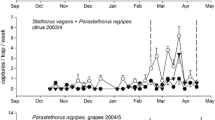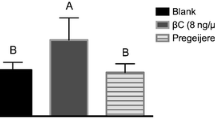Abstract
Synthetic methyl salicylate (MeSA), a herbivore-induced plant volatile (HIPV), was demonstrated to be an attractant for the green lacewing, Chrysopa nigricornis, in two field experiments conducted in a Washington hop yard. Significantly greater numbers of C. nigricornis were trapped on MeSA-baited sticky cards (mean: 2.8 ± 0.4/card/week) than on unbaited cards (0.45 ± 0.15) during June–September. Cards baited with two other HIPVs, hexenyl acetate and dimethyl nonatriene, did not attract more C. nigricornis than did unbaited traps (0.30 ± 0.10, 0.44 ± 0.15, respectively). MeSA-baited Unitraps captured 1.9 ± 0.5 C. nigricornis/trap/week during July–August compared to 0.20 ± 0.20/trap/week in methyl eugenol-baited traps and 0.03 ± 0.03/trap/week in unbaited traps. The potential use of MeSA in enhancing C. nigricornis populations in Washington hop yards as an aid to conservation biological control of aphids and mites is discussed.
Similar content being viewed by others
References
Agnew, C. W., Sterling, W. L., and Dean, D. A. 1981. Notes on the Chrysopidae and Hemerobiidae of Eastern Texas with keys for their identification. Southwest. Entomol. 4(Suppl.):1–20.
Agrawal, A. A., Janssen, A., Bruin, J., Posthumus, M. A., and Sabelis, M. W. 2002. An ecological cost of plant defence: Attractiveness of bitter cucumber plants to natural enemies of herbivores. Ecol. Lett. 5:377–385.
Bolter, C. J., Dicke, M., van Loon, J. J. A., Visser, J. H., and Posthumus, M. A. 1997. Attraction of Colorado potato beetles to herbivore-damaged plants during herbivory and after its termination. J. Chem. Ecol. 23:1003–1023.
Caltagirone, L. E. 1969. Terpenyl acetate bait attracts Chrysopa adults. J. Econ. Entomol. 62:1237.
Campbell, C. A. M., Pettersson, J., Pickett, J. A., Wadhams, L. J., and Woodcock, C. M. 1993. Spring migration of Damson-Hop aphid, Phorodon humuli (Homoptera: Aphididae), and summer host plant-derived semiochemicals released on feeding. J. Chem. Ecol. 19:1569–1576.
Dicke, M. and Sabelis, M. W. 1988. How plants obtain predatory mites as bodyguards. Neth. J. Zool. 38:148–165.
Dicke, M., Sabelis, M. W., Takabayashi, J., Bruin, J., and Posthumus, M. A. 1990. Plant strategies of manipulating predator–prey interactions through allelochemicals: Prospects for application in pest control. J. Chem. Ecol. 16:3091–3118.
Dicke, M., Takabayashi, J., Posthumus, M. A., Schutte, C., and Krips, O. E. 1998. Plant–phytoseiid interactions mediated by prey-induced plant volatiles: Variation in production of cues and variation in responses of predatory mites. Exp. Appl. Acarol. 22:311–333.
Drukker, B., Bruin, J., and Sabelis, M. 2000. Anthocorid predators learn to associate herbivore-induced plant volatiles with presence or absence of prey. Physiol. Entomol. 25:260–265.
Drukker, B., Scutareanu, P., and Sabelis, M. W. 1995. Do anthocorid predators respond to synomones from Psylla-infested pear trees under field conditions? Entomol. Exp. et Applicata 77:193–203.
Flint, H. M., Slater, S. S.l., and Walters, S. 1979. Caryophyllene: An attractant for the green lacewing. Environ. Entomol. 8:1123–1125.
Geervliet, J. B. F., Posthumus, M. A., Vet, L. E. M., and Dicke, M. 1997. Comparative analysis of headspace volatiles from different caterpillar-infested and uninfested food plants of Pieris species. J. Chem. Ecol. 23:2935–2954.
Glinwood, R. and Pettersson, J. 2000. Host plant choice in Rhopalosiphum padi spring migrants and the role of olfaction in winter host leaving. Bull. Entomol. Res. 90:57–61.
Hardie, J., Isaacs, R., Pickett, J. A., Wadhams, L. J., and Woodcock, C. M. 1994. Methyl salicylate and (–)-(1R,5S)-myrtenal are plant-derived repellents for black bean aphid, Aphis fabae Scop. (Homoptera: Aphididae). J. Chem. Ecol. 20:2847–2855.
Hunter, M. D. 2002. A breath of fresh air: Beyond laboratory studies of plant volatile–natural enemy interactions. Agric. Forest Ent. 4:81–86.
James, D. G. in preparation 2003. Synthetic herbivore-induced plant volatiles as attractants for beneficial insects.
James, D. G., Price, T. S., and Wright, L. C. 2003. Mites and aphids in Washington hops: Candidates for augmentative or conservation biological control? Proc. 1 st Int. Symp. Biol. Cont. Arthropods
James, D. G., Price, T. S., Wright, L. C., Coyle, J., and Perez, J. 2001. Mite abundance and phenology on commercial and escaped hops. Int. J. Acarol. 27:151–156.
Kessler, A. and Baldwin, I. T. 2001. Defensive function of herbivore-induced plant volatile emissions in nature. Science 291:2141–2144.
Lluisa, J. and Penuelas, J. 2001. Emission of volatile organic compounds by apple trees under spider mite attack and attraction of predatory mites. Exp. Appl. Acarol. 25:65–77.
Losel, P. M., Lindemann, M., Scherkenbeck, J., Maier, J., Engelhard, B., Campbell, C. A. M., Hardie, J., Pickett, J. A., Wadhams, L. J., and Elbert, A. 1996. The potential of semiochemicals for control of Phorodon humuli (Homoptera: Aphididae). Pesticide Sci. 48:293–303.
Ninkovic, V., Ahmed, E., Glinwood, R., and Pettersson, J. 2003. Effects of two types of semiochemical on population development of the bird cherry oat aphid Rhopalosiphum padi in a barley crop. Agric. Forest Entomol. 5:27–33.
Ockroy, M. L. B., Turlings, T. C. J., Edwards, P. J., Fritzsche-Hoballah, M. E., Ambrosetti, L., Bassetti, P., and Dorn, S. 2001. Response of natural populations of predators and parasitoids to artificially induced volatile emissions in maize plants (Zea mays L.). Agric. Forest Ent. 3:201–209.
Ozawa, R., Arimura, G., Takabayashi, J., Shimoda, T., and Nishioka, T. 2000b. Involvement of jasmonate and salicylate-related signalling pathway for the production of specific herbivore-induced volatiles in plants. Plant Cell Physiol. 41:391–398.
Ozawa, R., Shimoda, T., Kawaguchi, M., Arimura, G., Horiuchi, J., Nishioka, T., and Takabayashi, J. 2000a. Lotus japonicus infested with herbivorous mites emits volatile compounds that attract predatory mites. J. Plant Res. 113:427–433.
Pare, P. W. and Tumlinson, J. H. 1996. Plant volatile signals in response to herbivore feeding. Fla. Entomol. 19:93–103.
Penny, N. D., Tauber, C. A., and De Leon, T. 2000. A new species of Chrysopa from western North America with a key to North American species (Neuroptera: Chrysopidae). Ann. Entomol. Soc. Am. 93:776–784.
Pettersson, J., Pickett, J. A., Pye, B. J., Quiroz, A., Smart, L. E., Wadhams, L. J., and Woodcock, C. M. 1994. Winter host component reduces colonization by bird-cherry-oat aphid, Rhopalosiphum padi (L.) (Homoptera: Aphididae) and other aphids in cereal fields. J. Chem Ecol. 20:2565–2574.
Rodriguez-Saona, C., Crafts-Brandner, S. J., Williams L III., and Pare, P. W. 2002. Lygus hesperus feeding and salivary gland extracts induce volatile emissions in plants. J. Chem. Ecol. 28:1733–1747.
Sabelis, M. W., Janssen, A., Pallini, A., Venzon, M., Bruin, J., Drukker, B., and Scutareanu, P. 1999. Behavioural responses of predatory and herbivorous arthropods to induced plant volatiles: From evolutionary ecology to agricultural applications. pp. 269-298, in A. Agrawal, S. Tuzun, and E. Bent (Eds.). Induced Plant Defences Against Pathogens and Herbivores. The American Phytopathological Society, St. Paul, Minnesota.
Sakan, T., Isoe, S., and Hyeon, S. B. 1970. The chemistry of attractants for Chrysopidae from Actinidia polygama Miq., pp. 237-247, in D. L. Wood, R. M. Silverstein, and M. Nakajima (Eds.). Control of Insect Behavior by Natural Products. Academic Press, New York.
Scutareanu, P., Drukker, B., Bruin, J., Posthumus, M. A., and Sabelis, M. W. 1997. Volatiles from psylla-infested pear trees and their possible involvement in attraction of anthocorid predators. J. Chem. Ecol. 23:2241–2260.
Shimoda, T., Takabayashi, J., Ashira, W., and Takafuji, A. 1997. Response of predatory insect, Scolothrips takahashi towards herbivore-induced plant volatiles under laboratory and field conditions. J. Chem. Ecol. 23:2033–2048.
Shulaev, V., Silverman, P., and Raskin, I. 1997. Airborne signalling by methyl salicylate in plant pathogen resistance. Nature 385:718–721.
Stowe, M. K., Turlings, T. C. J., Loughrin, J. H., Lewis, W. J., and Tumlinson, J. H. 1995. The chemistry of eavesdropping, alarm and deceit. Proc. Nat. Acad. Sci. USA 92:23-28
Suda, D. Y. and Cunningham, R. T. 1970. Chrysopa basalis captured in plastic traps containing methyl eugenol. J. Econ. Entomol. 63:1706.
Takabayashi, J. and Dicke, M. 1996. Plant–carnivore mutualism through herbivore-induced carnivore attractants. Trends Plant Sci. 1:109–113.
Takabayashi, J., Dicke, M., and Posthumus, M. A. 1994. Volatile herbivore-induced terpenoids in plant–mite interactions: Variation caused by biotic and abiotic factors. J. Chem. Ecol. 20:1329–1354.
Thaler, J. S. 1999. Jasmonate-inducible plant defences cause increased parasitism of herbivores. Nature 399:686–688.
Turlings, T. C. J., Tumlinson, J. H., and Lewis, W. J. 1990. Exploitation of herbivore-induced plant odors by host-seeking parasitic wasps. Science 250:1251–1253.
Turlings, T. C. J., Wackers, F. L., Vet, L. E. M., Tumlinson, J. H., and Lewis, W. J. 1993. Learning of host-finding cues by hymenopterous parasitoids, pp. 51-78, in D. R. Papaj and A. C. Lewis (Eds.). Insect Learning. Chapman and Hall, New York.
Umeya, K. and Hirao, J. 1975. Attraction of the Jackfruit fly, Dacus umbrosus F. (Diptera: Tephritidae) and lacewing, Chrysopa sp. (Neuroptera: Chrysopidae) by lure traps baited with methyl eugenol and cue-lure in the Philippines. Appl. Entomol. Zool. 10:60–62.
Van Emden, H. F., and Hagen, K. S. 1976. Olfactory reactions of the green lacewing, Chrysopa carnea, to tryptophan and certain breakdown products. Environ. Entomol. 5:469–473.
Vet, L. E. M. and Dicke, M. 1992. Ecology of infochemical use by natural enemies in a tritrophic context. Annu. Rev. Entomol. 37:141–172.
Zhu, J., Cosse, A. A., Obrycki, J. J., Boo, K. S., and Baker, T. C. 1999. Olfactory reactions of the twelve-spotted lady beetle, Coleomegilla maculata and the green lacewing, Chrysoperla carnea to semiochemicals released from their prey and host plants: Electroantennogram and behavioral responses. J. Chem. Ecol. 25:1163–1177.
Author information
Authors and Affiliations
Corresponding author
Rights and permissions
About this article
Cite this article
James, D.G. Field Evaluation of Herbivore-Induced Plant Volatiles as Attractants for Beneficial Insects: Methyl Salicylate and the Green Lacewing, Chrysopa nigricornis . J Chem Ecol 29, 1601–1609 (2003). https://doi.org/10.1023/A:1024270713493
Issue Date:
DOI: https://doi.org/10.1023/A:1024270713493




